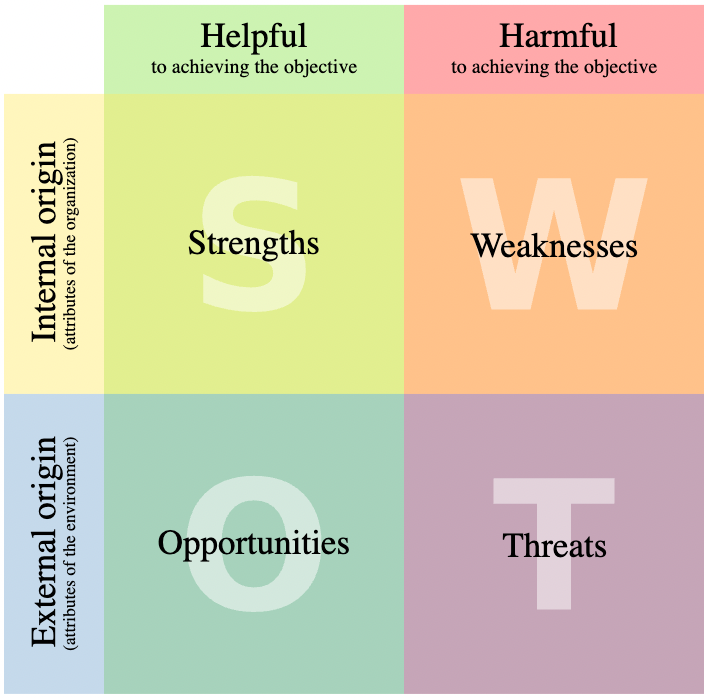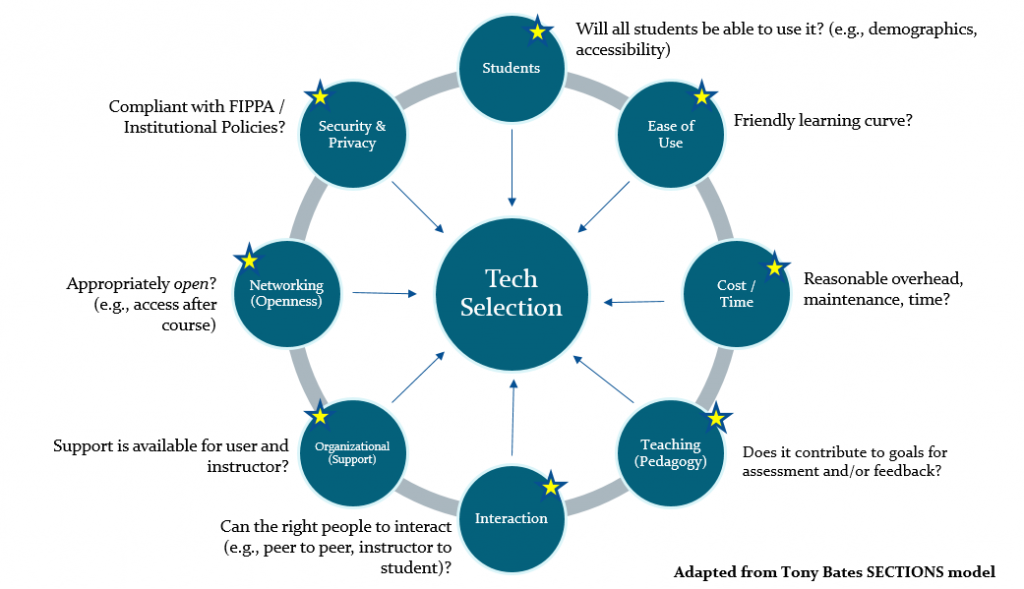What is an EdTech Leader?
Overview
In this chapter we’ll be examining what leaders in educational technology look like, along with common technology integration models and the usefulness of needs analyses in deciding how to integrate technology to meet a specific educational goal.
Learning Outcomes
- Understand what edtech leadership looks like in different contexts (e.g., Schools, Universities, corporate, etc.) and what their responsibilities are.
- Identify an appropriate model for Technology Integration
- Identify teaching and learning needs that could be served with technologies.
- Understand the basics of a Needs and SWOT analysis.
Why is this important?
As many educators work in different sectors (schools / K-12 (Kinder – Year 12), university, polytechnic / TAFE, military and corporate), gaining and understanding of what leadership in learning / educational technology looks like is the first step in understanding the work that they do
Guiding Questions
As you’re reading through these materials, please consider the following questions, and take notes to ensure you understand their answers as you go.
- What does leadership look like in your area? How do leaders engage with others as they act in a leadership capacity?
- What decisions do these people make, and how do they go about making them?
Key Readings
Davies, P. M. (2010). On school educational technology leadership. Management in education, 24(2), 55-61.
Webster, M. D. (2017). Philosophy of technology assumptions in educational technology leadership. Journal of Educational Technology & Society, 20(1), 25-36.
Terminology
Before we begin, it’s important to address terminology once again. For the purposes of this book, the term ‘Educational Technology’ will be used as a catch all to discuss any technologies or efforts to use technologies in an educational setting. This can encompass, but is not limited to ICT (Information and Communication Technologies) Education, Learning Technologies, Digital Learning, Digital Competencies, eLearning, online learning and many more terms. As many of these terms relate to specific sectors and requirements ‘Educational Technology’ is used around the world as a descriptive and general term.
Leadership in Educational Technology

Leaders in edtech look very different depending on the sector and the roles they play in their institution.
How educational technology leadership is formally structured and how it works in practice will differ greatly between institutions, so it is important to recognise that there is no ‘right’ way to engage in this work, because sometimes initiatives can be top-down, other times they can be bottom-up, with the ideal being a mix of the two. Given the evolution of information technology into educational and learning technology over the last 20 years, most leaders in edtech recognise that change and innovation can’t come about from the top or the bottom, but with the two working together, both in the exploration and implementation of technology.
In Schools / K-12
In some contexts, Principals are often considered to the de-facto edtech leaders, as ICT integration is folded into their many responsibilities. With this top-down leadership approach (thought not always intentionally this way), principals can face challenges in their work in this area, as it may feel too leadership-centric.
Other contexts, the role of edtech leaders falls to domain specific teaching leaders – more often than not, those in STEM fields (Science, Technology, Engineering and Maths). Given that these teachers are usually not in an institutional leadership position, they are often seen more as an ‘edtech influencer’ and someone who other teachers might go to for assistance with technology integration for teaching and learning purposes.
Tertiary / Higher Education and Polytechnic / TAFE
Because universities and polytechnic institutions are typically very large and hierarchal, edtech leadership looks quite different in this space. Often there are those in formal leadership roles specifically focusing on educational technology at different levels. You may have senior managers at the institutional or lower departmental levels and even teachers ‘on the ground’ working with educational technology and driving change from their level.
In some organisations there may be little difference between IT and edtech leadership, whereas in others, there may be a clear delineation. The relationship between these two fields, as well as their overlap can also influence how decisions are made based on the perceived priorities of each.
Many institutions also have dedicated instructional / learning designers and educational technology support staff, who serve a kindof ‘influence / support’ hybrid role because they often train on and demonstrate how technology can be used to support teaching and learning related to the projects and people they work with.
Military
In Military contexts, edtech leadership is primarily based on well-articulated structures and means of teaching and learning (or training if you like) with technology, with those in various levels of the chain of command making decisions regarding training and technology use. Individual instructors may have little choice in terms of exploring or pushing edtech forward as many training programs and the associated technologies are prescribed by others.
Corporate
These contexts can also differ greatly, depending on the size, organisational structure, and aims of a company. Educational Technology leaders may fit into similar roles of those outlined in schools / K-12, universities or the military. If the focus of education in a company is to specifically train on skills, edtech leadership would most likely be involved in tool selection and outlining how to use these tools, whereas for a more ‘soft skills’ approach in corporation learning environments, more exploration and collaboration may be the norm. Additionally, like in other contexts, its possible that IT staff play a larger role in educational techology leadership due to a lack of roles in educational technology specifically.
Hub and Spoke Model

A common model for distribution of goods and organisation is referred to the Hub and Spoke model. This refers to a model in which there is a central leadership or point of contact for leadership, with the spokes branching out in many different directions, leading to other points of contact for lower levels of leadership. This model is very common in larger organisations when it comes to edtech leadership, because it allows lower level leaders to make more appropriate decisions at that lower level (e.g. institution-level decisions are very different than departmental decisions)
What about IT?
Further still, there are IT support staff who assist in the implementation and use of technologies. In the early days of digital learning, many technology-based decisions in schools were made by IT staff who have great understandings of technology, but may not fully understand teaching and learning practice. As time has gone on, more decision-making power has shifted to those using the technology for teaching and learning, leaving IT staff to focus more on administrative and operational technologies such as email, networking and communications technologies
This is another reason why ‘edtech’ is used in this book, as the term ICT is often still misconstrued with IT, because it has the letters ‘I’ and ‘T’ in it 😉
Thought Leaders
Another category of leader you may have encountered is someone considered to be a ‘Thought Leader’. These leaders can be very broad in how they approach leadership and generally share big ideas that span an entire sector, sharing their expertise in many ways, such as online through professional networks and presenting at conferences and invited lectures, which may or may not be based on empirical research. Some thought leaders are teachers in schools, or they are prominent researchers, while others may be CEOs of edtech firms. Depending on their affiliations and interests, their contributions to our understanding of teaching and learning and the insights they provide in edtech leadership can vary greatly.
Identifying Needs & Solving Problems
As part of an overall identification of needs, we can take a look at the Needs Analysis process as applied to eLearning or Learning technologies. The video below outlines this very well, albeit for a very specific context. In the previous section of this chapter, it is clear that leadership can occur at many levels. In terms of leadership needs, you can think about needs in terms of how change can be affected in small or large scale performance or learning gaps, that span across a few classes, many classes or an institution. As opposed to the Analysis part of ADDIE (for more see Models of Design in Introduction to Learning with Technology), a Needs Analysis can either be broad or specific in application and more general in how we tend to think about solving problems, without a specific focus on designing a learning experience.
Given that edtech leadership can come in many forms, starting with a Needs Analysis framework can help us to identify a general need, then if we need to get specific with other frameworks, we can. Instead of looking at how individual students in a given class or subject may not be achieving specific goals or learning what they need to learn, we can look across groups of classes or across the institution to see how things could be improved. What needs are not currently being met and how can technology bridge this gap?
This work can be done informally, through conversations with interested parties, or in a very formal and structured way, by actually undertaking evaluative research, collecting data and justifying choices based on this data, or it can be more informal, exploratory and based on professional experience and expertise. In terms of that research side of things, identifying a need can also come about through the use of educational data to identify gaps or problems that need to be solved. For more on educational data, feel free to check out the book, Introduction to Learning Analytics.
Additionally, a needs analysis is also useful in terms of looking at technology as well as their users. It’s incredibly important not to assume that technology will solve a problem, simply because it exists. The people who use these technologies play an important role. For example, the implementation and rollout of a new technology can fall 100% flat if users don’t even want to use the technology, are unfamiliar with it, or don’t know how to use it effectively, so ensuring that a technology is the right one to fill the need also means exploring the viability of technologies *IF* they are chosen. Engaging in this sort of analysis and research can mean the difference between changing the culture of an institution and having tens of thousands of dollars worth of equipment sitting on the shelf and gathering dust.
SWOT Analyses
A very common way to think about analysis of a project, product or process in any organisational change and leadership context is the SWOT analysis, which refers to Strengths, Weaknesses, Opportunities and Threats.
In the context of educational technology, the ways in which we interpret these individual words will differ greatly, but this is a good place to start when thinking about how technology and its integration into a teaching and learning environment can affect change.
Strengths may refer to the ease of use of a technology or its ability to be deployed easily across many teachers / learners.
Weaknesses might range from privacy concerns for how its collects data or the sustainability of a hardware product and its need for constant maintenance.
Opportunities may relate to pedagogical affordances and how something engages learners more actively, or it may speak to how it advances teachers in their own practice.
Threats may come in the form of how a technology may be used for nefarious purposes by an external party, or even how it may influence teaching and learning in a larger scale, but to the detriment of learning itself.

Models of Technology Integration
Another way to help us think about using technology in our teaching is through different technology integration models. While this is covered more in depth in the book Introduction to Learning Technology (including references), the videos below should give you a good overview.
A good model for tech integration on a larger scale (e.g., outside of a single classroom or teacher’s use of technology) is SECTIONS, by Tony Bates as it focuses more on the adoption of technology from a broader perspective for teaching and learning across an organisation.

SAMR
TPACK
PICRAT
Key Take-Aways
- Edtech leadership looks different in different contexts
- Needs Analysis and SWOT analysis can help us to identify gaps and improve things in a broad sense.
- Technology integration models can help us make decisions around how to select and implement technology
Revisit Guiding Questions
Consider what leadership looks like where you work or study. Clarity around who is in a formal vs. informal leadership position will differ everywhere, so considering what it looks like in your context, as well as how you perceive different people, and how you make decisions if you are a leader will also differ. Have a think about the kinds of projects you’d like to work on, where your interests lie and how you can be the most effective edtech leader.
References
Bates, A. W. (2015). Chapter 8: Choosing and using media in education: The SECTIONS model. In Teaching in a Digital Age. [Open source e-book]. Retrieved from https://opentextbc.ca/teachinginadigitalage/part/9-pedagogical-differences-between-media/
Hamilton, E. R., Rosenberg, J. M., & Akcaoglu, M. (2016). The substitution augmentation modification redefinition (SAMR) model: A critical review and suggestions for its use. TechTrends, 60(5), 433-441.
Kimmons, R., Graham, C. R., & West, R. E. (2020). The PICRAT model for technology integration in teacher preparation. Contemporary Issues in Technology and Teacher Education, 20(1), 176-198.
Mishra, P., & Koehler, M. J. (2008, March). Introducing technological pedagogical content knowledge. In annual meeting of the American Educational Research Association (pp. 1-16).
Woodside, W. (2019). Blended Learning, Digital Natives and the Effective Application of Learning Technologies in Army.
Did this chapter help you learn?
No one has voted on this resource yet.